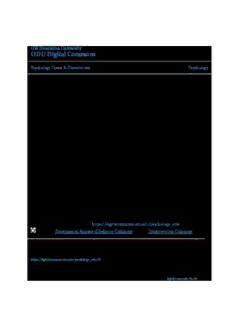Table Of ContentOOlldd DDoommiinniioonn UUnniivveerrssiittyy
OODDUU DDiiggiittaall CCoommmmoonnss
Psychology Theses & Dissertations Psychology
Summer 2016
EEffffeeccttss ooff VViissiibbiilliittyy aanndd AAllaarrmm MMooddaalliittyy oonn WWoorrkkllooaadd,, TTrruusstt iinn
AAuuttoommaattiioonn,, SSiittuuaattiioonn AAwwaarreenneessss,, aanndd DDrriivveerr PPeerrffoorrmmaannccee
Smruti J. Shah
Old Dominion University, [email protected]
Follow this and additional works at: https://digitalcommons.odu.edu/psychology_etds
Part of the Experimental Analysis of Behavior Commons, and the Transportation Commons
RReeccoommmmeennddeedd CCiittaattiioonn
Shah, Smruti J.. "Effects of Visibility and Alarm Modality on Workload, Trust in Automation, Situation
Awareness, and Driver Performance" (2016). Master of Science (MS), Thesis, Psychology, Old Dominion
University, DOI: 10.25777/1hr1-rn20
https://digitalcommons.odu.edu/psychology_etds/36
This Thesis is brought to you for free and open access by the Psychology at ODU Digital Commons. It has been
accepted for inclusion in Psychology Theses & Dissertations by an authorized administrator of ODU Digital
Commons. For more information, please contact [email protected].
EFFECTS OF VISIBILITY AND ALARM MODALITY ON WORKLOAD,
TRUST IN AUTOMATION, SITUATION AWARENESS, AND DRIVER
PERFORMANCE
by
Smruti J. Shah
B.S. May 2013, Old Dominion University
A Thesis Submitted to the Faculty of Old Dominion University in Partial Fulfillment of the
Requirements for the Degree of
MASTER OF SCIENCE
PSYCHOLOGY
OLD DOMINION UNIVERSITY
August 2016
Approved by:
James P. Bliss (Director)
Yusuke Yamani (Member)
Richard Landers (Member)
ABSTRACT
EFFECTS OF VISIBILITY AND ALARM MODALITY ON WORKLOAD,
TRUST IN AUTOMATION, SITUATION AWARENESS, AND DRIVER PERFORMANCE
Smruti J. Shah
Old Dominion University, 2016
Director: Dr. James P. Bliss
Driving demands sustained driver attention. This attentional demand increases with
decreasing field visibility. In the past researchers have explored and investigated how collision
avoidance warning systems (CAWS) help improve driving performance. The goal of the present
study is to determine whether auditory or tactile CAWS have a greater effect on driver
performance, perceived workload, system trust, and situation awareness (SA). Sixty-three
undergraduate students from Old Dominion University participated in this study. Participants
were asked to complete two simulated driving sessions along with Motion Sickness
Susceptibility Questionnaire, Background Information Questionnaire, Trust Questionnaire,
NASA Task Load Index Questionnaire, Situation Awareness Rating Technique Questionnaire,
and Simulator Sickness Questionnaire. Analyses indicated that drivers in the tactile modality
condition had low perceived workload. Drivers in the heavy fog visibility condition had the
highest number of collisions and red-light tickets. Drivers in the heavy fog condition also
reported having the highest overall situation awareness. Drivers in the clear visibility condition
trusted tactile alarms more than the auditory alarms, whereas drivers in the heavy fog condition
trusted auditory alarms more than tactile alarms. The findings of this investigation could be
applied to improve the design of CAWS that would help improve driver performance and
increase safety on the roadways.
© Copyright, 2016, by Smruti J. Shah, All Rights Reserved.
iv
This thesis is dedicated to my immensely supportive family.
v
ACKNOWLEDGEMENTS
I would like to thank Dr. James Bliss, my faculty advisor, for providing me challenges
that helped me expand my horizons, and for his guidance throughout my graduate years at Old
Dominion University. I extend my gratitude to my committee members, and Dr. Elaine Justice
for their advice and feedback on my research. I would also like to thank my family for their
continued support.
vi
TABLE OF CONTENTS
Page
LIST OF TABLES.……….……………………………………………………………….……viii
LIST OF FIGURES ………………………………………………...…………………………....ix
INTRODUCTION….………………….………………...………………………………………..1
VISIBILITY…………………………………..…….…….........…………………………….3
SITUATION AWARENESS………………………..……………………………………….6
MULTIPLE RESOURCE THEORY………………...............................................................7
ALARM MODALITIES …….………………………………………………………………8
COLLISION AVOIDANCE WARNING SYSTEM (CAWS)……………………………..12
GOAL AND PURPOSE OF THE STUDY.…………………………...……………………14
DRIVER PERFORMANCE HYPOTHESES...................................................................15
NUMBER OF COLLISIONS ……………..……………..………............................15
RED-LIGHT TICKETS…………………………..…………………………………16
NUMBER OF SPEED EXCEEDANCE……………………………………………16
SITUATION AWARENESS HYPOTHESIS…………………………………...............16
RESEARCH QUESTION (SA) …………………………………………………….16
TRUST IN AUTOMATION HYPOTHESIS……………………………………………17
RESEARCH QUESTION (TRUST)...……………………………………………...17
WORKLOAD HYPOTHESES……….…….....………….……………………………...17
METHOD.…………….…..…………….…………………………...………………….……….18
EXPERIMENTAL DESIGN ……….……………………………………..……………..…18
PARTICIPANTS ……………...…………………………………………………………....19
MATERIALS …….……………………………………………...........................................20
INFORMED CONSENT………….………………………………………..……………20
BACKGROUND INFORMATION QUESTIONNAIRE..…….………………………..21
MOTION SICKNESS SUSCEPTIBILITY QUESTIONNAIRE………………………..21
NASA TASK LOAD INDEX...…….…...……..…………………..…………………….21
TRUST QUESTIONNAIRE ......………….…...…….…………………………………..22
SITUATION AWARENESS RATING TECHNIQUE SCALE.………………………..22
SIMULATION SICKNESS ASSESSMENT..…….……..………...……………………23
EQUIPMENT...…….……………………….………………...........................................24
PROCEDURE …………………………….……………………...........................................26
RESULTS ……………………………………………….………...…………………………….28
NUMBER OF COLLISION………………………….……...……………………………...29
CORRELATIONAL ANALYSIS………………………...…..…………………………30
NUMBER OF RED-LIGHT TICKET………………………………………………………31
NUMBER OF SPEEDEXCEEDANCE..…………………………………….......................32
SITUATION AWARENESS………….…………….……………….……………………...32
WORKLOAD..……………………………………….…………..........................................34
vii
Page
TRUST IN CAWS………………………………………….……………………………….36
POST-EXPERIMENT SIMULATOR SICKNESS…………………………………………37
DISCUSSION …...…………………………………………….……….………………………..38
DRIVER PERFORMANCE………………..…………………….........................................38
SITUATION AWARENESS……….…………………...………..........................................40
WORKLOAD……….……………………….………………………...................................41
TRUST IN AUTOMATION SYSTEM…………..……...………………………………….42
LIMITATIONS …………………………………………………..........................................43
CONCLUSION………………………………………………………...………………………...45
REFERENCES.………………………………………………………………………………….47
APPENDICES
A. INFORMED CONSENT.……...……………………….…………………………….….55
B. BACKGROUND QUESTIONNAIRE...…………………………...................................58
C. MOTION SICKNESS SUSCEPTIBILITY QUESTIONNAIRE.…..…………………...60
D. SIMULATION SICKNESS QUESTIONNAIRE (SSQ- SHORT)...……........................61
E. NASA-TLX …………..……………………………………………….............................62
F. TRUST QUESTIONNAIRE ………………………………..……...................................63
G. SITUATION AWARENESS RATING SCALE (SART)……….…...…….…................65
H. PICTURES OF THE EXPERIMENTAL EQUIPMENT…….…..…...…….…………...67
I. CORRELATION MATRIX TABLE.……………………..……………………………..69
VITA …………………………………………………………….………………………............70
viii
LIST OF TABLES
Table Page
1. Means, standard errors, and confidence intervals for each level of workload across
modality condition ………………………....................................................................................36
ix
LIST OF FIGURES
Figure Page
1. Screen-shots of simulated visibility conditions……………………………..……………….28
2. Average number of collisions across alarm modality and visibility conditions……………..30
3. Average number of red-light ticket received by drivers across visibility and alarm
modality conditions………………………………………………………………………………32
4. Drivers’ situation awareness across visibility and alarm modality conditions………………33
5. Components of situation awareness (SA) across visibility conditions………………………34
6. Average perceived workload across alarm modality and visibility conditions ….………….35
7. Drivers’ trust in the CAWS across visibility and alarm modality conditions………………..37

